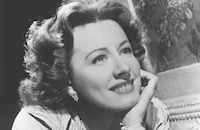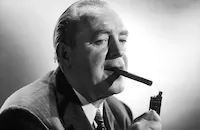Consolation Marriage

Brief Synopsis
Cast & Crew
Paul Sloane
Irene Dunne
Pat O'brien
John Halliday
Myrna Loy
Lester Vail
Film Details
Technical Specs

Synopsis
After their respective lovers, Elaine Brandon and Aubrey, jilt them to marry wealthier suitors, Steve Porter and Mary Brown meet and become close friends. Although they are still in love with their former flames, Steve, a New York sports reporter, and Mary, a shop owner, decide to marry, agreeing to an "open" arrangement. Consequently, when Steve learns that Elaine is divorcing her rich English husband, he makes plans to leave for London and rejoin her, but then finds out that Mary is pregnant and that Jeff, his editor, has fired him. Still true to their marital agreement, Mary encourages Steve to go to Elaine, but he dutifully remains to take care of their baby girl. On the morning of their second wedding anniversary, however, Steve receives word from Elaine that she is in town and wants to see him. While Steve is having his hair cut in anticipation of meeting Elaine, Mary is called on by Aubrey, a classical pianist who has just deserted his unhappy marriage. Sure that the other mate wants to end the marriage, both Steve and Mary arrange to leave New York with their would-be lovers. Before either one can go through with the separation, however, each one, realizing not only their love for their child, but their love and need for each other, returns home.

Director
Paul Sloane
Cast

Irene Dunne

Pat O'brien

John Halliday

Myrna Loy

Lester Vail
Matt Moore
Crew
Willard Barth
Fred Bentley
Charles Burke
Robert Coburn
Myles Connolly
William Cunningham
J. Roy Hunt
Charles Kerr
William Lebaron
Archie F. Marshek
Humphrey Pearson
Edward Pyle
Frank Redman
Max Rée
Max Rée
Max Steiner
Fred Terzo
John E. Tribby

Videos
Movie Clip



Film Details
Technical Specs

Articles
Consolation Marriage
It was directed by Paul Sloane, a movie industry veteran who had started his career as a writer in 1915 and branched out into directing several years later. He worked for a variety of studios in a wide range of projects, including helming the first all-black-cast feature, Hearts in Dixie, in 1929 and directing several musical comedies starring comedians Wheeler and Woolsey. In Consolation Marriage, Sloane worked with a solid cast of both relative newcomers like Dunne and others with more credits on their resumes.
Irene Dunne started her show business career in music, studying both piano and voice as a child and continuing her education at the Chicago College of Music. A gifted soprano, Irene had dreams of an operatic career but was not accepted by the Metropolitan Opera Company after auditioning for them, so she pursued a stage career in musical comedy instead. During the 1920s she appeared in many Chicago-based road shows of popular musicals, finally breaking out as a star attraction in Show Boat and coming to the attention of Hollywood studios while the show was running in Los Angeles. After only one non-eventual film appearance (Leathernecking, 1930), the savvy Irene Dunne, realizing she needed to expand her horizons, decided to study drama for six months. It was a wise move, as she gained the confidence necessary to audition and win the role in the career-making Cimarron, and a star was born.
Co-starring opposite Irene Dunne was actor Pat O'Brien, a childhood friend of Spencer Tracy. Both of them attended military school and served together in the Navy during WWI, and after the war they decided to attend drama school in New York, and both began their acting careers soon afterwards. O'Brien got his big break and garnered the attention of Hollywood when he starred in The Front Page on Broadway, and was asked to join the cast when it was made into a movie in 1931. He would go on to enjoy a sixty-year movie and television career, often playing the quintessential Irishman, complete with a heavy, charming and obviously theatrical Irish brogue.
The character of Pat O'Brien's errant fiancée was played by Montana-born Myrna Loy, who despite being only twenty-five years old had already been in over sixty films since making her movie debut only six years earlier. The daughter of a cattleman/state legislator who died in the 1918 flu epidemic, Myrna's family relocated to Los Angeles where she found work as a dancer in the Grauman's Chinese Theater chorus line and began pounding the pavement hoping for an entry into the motion picture industry. Her piquant good looks eventually helped her break in, landing her parts as exotic beauties in a parade of films including 1925's Ben-Hur, Don Juan (1926) with John Barrymore, A Connecticut Yankee (1931) opposite Will Rogers, and many more. For Consolation Marriage, the normally brunette Myrna Loy was changed into a shimmering blonde, adding to her character's allure as a thrill-seeking, globe-trotting glamour girl. O'Brien's boss was played by John Halliday, a well-regarded character actor, Brooklyn-born but often cast in British or international roles, who is probably best known for his role as Katharine Hepburn's father in The Philadelphia Story (1940).
The production of Consolation Marriage was completed in August of 1931, including a complete cast and crew vehicle caravan field trip up to San Francisco's Steinhart Aquarium for a scene involving two rare seahorses. The movie premiered at the Cathay Theatre in Los Angeles on October 15, 1931, and the critical reception of the film was favorable. At the premiere, venerable Hollywood emcee Ken Murray managed to forget relative newcomer Pat O'Brien's name, and the energetic actor took the opportunity to commandeer the microphone and proceed to enthusiastically thank the entire cast and crew of the film.
Nearly fifty years after Consolation Marriage, Pat O'Brien and Myrna Loy appeared onscreen together again, this time playing the parents of star Burt Reynolds in his 1978 comedy The End. In her autobiography, Loy remembered the acting tip that O'Brien gave while they were making Consolation Marriage. "Stop acting with your neck!" he advised her, noting how she was tensing up her neck muscles to portray emotion instead of generating it internally. When they were reunited in The End, Myrna Loy happily thanked Pat O'Brien for his sage advice which had served her well over her long and distinguished career.
For an opportunity to see some Hollywood screen favorites in early roles, in a movie with a titillating premise, Consolation Marriage is a rare treat. You may wonder how far men and women have come in relating to each other, but you won't wonder why Irene Dunne, Pat O'Brien and Myrna Loy went on to become big Hollywood stars. They're simply great.
Producer: Myles Connolly, William LeBaron
Director: Paul Sloane
Screenplay: Humphrey Pearson, Bill Cunningham
Cinematography: J. Roy Hunt
Film Editing: Archie Marshek
Art Direction: Max Ree
Music: Max Steiner
Cast: Irene Dunne (Mary Brown Porter), Pat O'Brien (Steve Porter), John Halliday (Jeff Hunter), Myrna Loy (Elaine Brandon), Lester Vail (Aubrey), Matt Moore (The Colonel).
BW-81m.
by Lisa Mateas

Consolation Marriage
Quotes
Trivia
Notes
The Hollywood premiere of Consolation Marriage was to be, according to RKO inter-office memos, the "first big opening since Cimarron, and the third in the history" of the company. Although she had a leading part in an earlier production, Bachelor Apartment, RKO considered "Mary Porter" to be Irene Dunne's first "starring" (name above the title) role. A Film Daily news item announced that Matt Moore was replacing Raymond McKee, who had replaced Hugh Herbert, in the role of the colonel. Variety gives the picture's running time as 62 minutes, but this length is probably an error. According to modern sources, Pat O'Brien was borrowed from Howard Hughes's Caddo Company for the production. This was the last film that O'Brien and Myrna Loy made together until the 1978 production The End. Modern sources include baby Pauline Stevens and Wilson Benge in the cast and state that associate producer Myles Connolly co-wrote the film's theme music, "Devotion," with Max Steiner.














